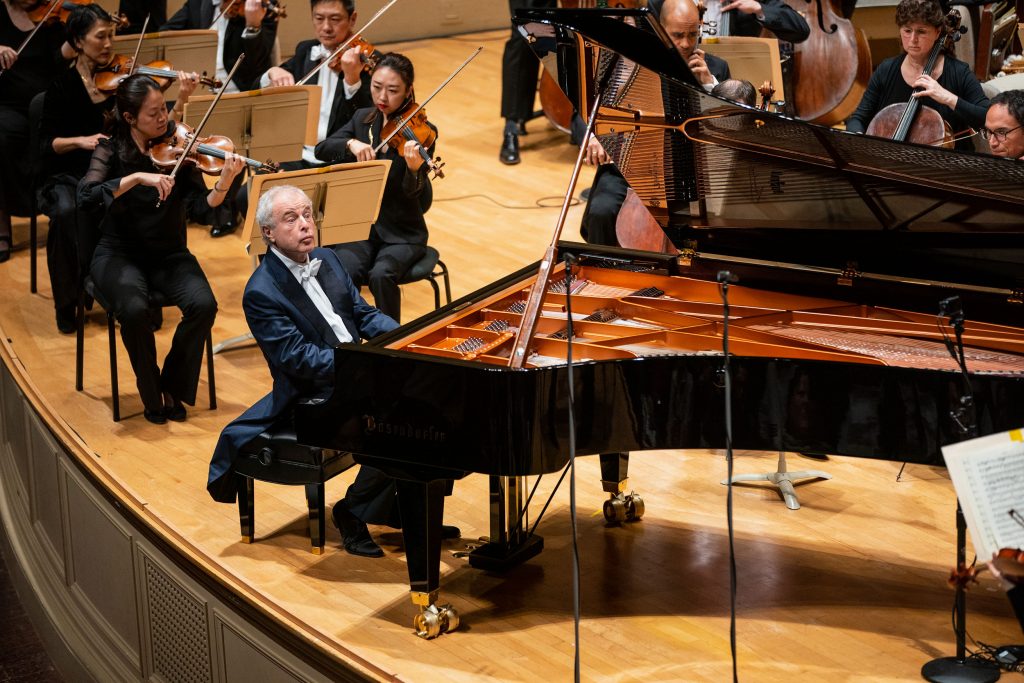Star turns in two roles for András Schiff in a welcome Boston Symphony return

With his vivid renditions of beloved classics, András Schiff remains at the peak of his powers. As a pianist, he plays with a technique and musicality that highlight every nuance of phrasing and texture. And as a conductor, he manages to find elements buried within scores that often go unnoticed.
Thursday night at Symphony Hall, in his first appearance with the Boston Symphony Orchestra since 2008, the Hungarian-born musician shed new light on well-trodden works by Beethoven and Bach in a dual role as pianist and conductor.
Schiff’s interpretations continue to result in fresh listening. In Thursday’s performance of Beethoven’s Piano Concerto No. 1, he delivered a performance marked by classical elegance that still managed to capture a sense of the adventurous composer to come. Though published as his first work in the genre, the Piano Concerto No. 1 was actually the second that Beethoven composed. Locked within its shapely melodies and supple orchestration is the sense of heroism and power that the composer would mine in later scores.
Schiff’s account deftly charted that mix of balance and exuberance. Throughout, his playing was crisp without becoming detached, and he shaped his phrases with just enough weight to draw attention to the sudden shifts in key. The first movement featured Schiff in gentle rubato shading that brought out the music’s lyrical moments in even the most demanding passages. The second theme made for a sublime contrast as his phrases meshed with the orchestra. Schiff’s subtle expressiveness heightened the development of the theme, with its air of searching mystery, and the recapitulation brought renewed dramatic force. Schiff’s cadenza was a true showpiece—by turns delicate and humorous, and thoroughly improvisational in flair.
The Rondo was shaped just as sensitively, as Schiff channeled a Mozartean grace through his rolling figures. He pushed the tempo in the central theme and carried its urgency to the movement’s conclusion. Though delicately rendered, one got the sense of just how groundbreaking Beethoven was even in this early work.
But the heart of this performance was the second movement, which Schiff shaped with a voice-like arc, piano lines coiling gently and then fading. The orchestra responded with power and grandeur as Schiff, conducting from the keyboard, highlighted each passing violin melody, brass call and clarinet passage.
J. S. Bach’s Keyboard Concerto in F minor BWV 1056, which opened the concert, also delivered rewarding musical moments. Completed in the 1730s while Bach was working in Leipzig, this short concerto with its flowering line calls for the pianist to walk a wire between continuo accompanist and featured soloist. Schiff excelled in both roles.
In the outer movements, he answered the orchestra with right-hand phrases that formed graceful arabesques while his left-hand figures supplied a gravity of sound. As with the Beethoven, the second movement was a sublime departure, and Schiff played with a sense of freedom to match the orchestra’s fluent, idiomatic accompaniment.
The lyrical charm of this keyboard concerto would also color the eventual encore, the Allegro Animato from Bach’s Italian Concerto, which followed the Beethoven concerto. Schiff then led equally compelling performances of symphonic works by Brahms and Bartók in the concert’s second half.
Brahms’s Variations of a Theme by Joseph Haydn is a lush treatment of a simple tune — a hymn called Chorale St. Antoni that was attributed to Haydn although it doesn’t appear to have originated with him. Brahms wrapped the chorale in a thick orchestral tapestry, and Schiff conducted it with a clear-eyed attention to detail that made the composer’s textures seem almost transparent.
In the variations, Schiff highlighted the iterations of each theme to Technicolor effect. He coaxed the first variation’s abstracted melody out from the chords that churn beneath sweeping violin passages. Robust horn and woodwind calls beamed from the sixth, and in the eighth Schiff kept all ears trained on the theme as it weaved its way through the violins and woodwinds. But he also maintained the big picture, and the disjointed phrases of the final passacaglia gradually cohered into a restatement of the chorale tune for a resounding conclusion.
Bartók’s Dance Suite, which closed the concert, carried just as much momentum. This lesser-known score of the composer’s from 1923 yields surprises, as bassoons and brasses grind out eerie dissonances against chugging strings. Dance rhythms also permeate the score, and its six short movements feature wild shifts in meter.
Schiff proved most adept at navigating between Bartók’s bristly textures and rustic bombast. Crushing harmonies from the trumpets, trombones and tuba provided an anchor to the woodwinds’ sly passages in the opening movements. Strings, piano, and harp offered silver-toned complement at the work’s center. And all forces converged for a frenzied finale — a bold finish to a balanced program led by a visitor who’d been away too long.
The program will be repeated 1:30 p.m. Friday and 8 p.m. Saturday at Symphony Hall. bso.org; 888-266-1200
Posted in Performances




